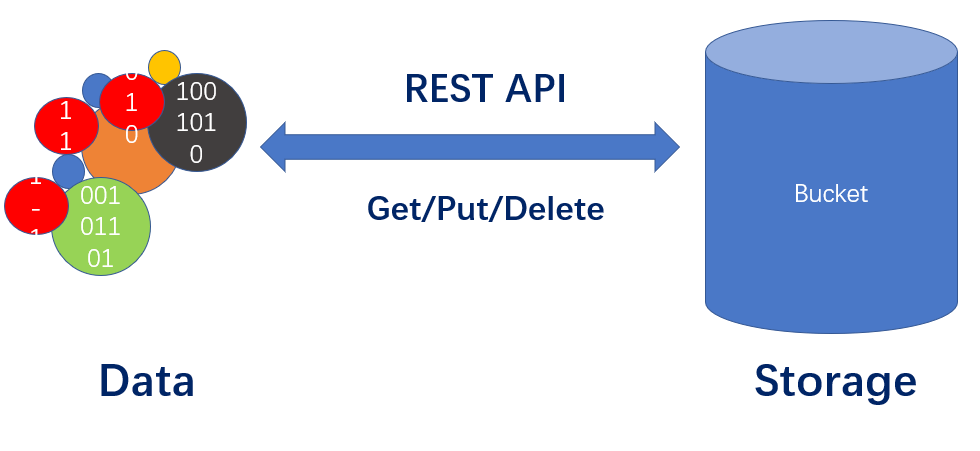February 01, 2021
1991
Two typical characteristics of object storage
1. RESTAPI interface
In layman's terms, the RESTAPI interface refers to processing resource information through HTTP actions.
The resources here refer to data such as articles, comments, files, users, etc. There are four types of HTTP processing actions: Get (Get), Create (Post), Modify (Put/Patch), Delete (Delete), each resource A specific URI address is generated correspondingly, and the process of object storage is actually to manipulate these unique URI addresses.

RESTAPI read and write diagram
2. Flat data organization structure
Compared with file systems, the second characteristic of object storage is the flat data organization structure, which fundamentally avoids maintaining a huge number of file directories. Object storage uses metadata retrieval to manage data. An Index or Key is obtained by matching metadata, and then the data is found and read based on this Index or Key.
For example, similar to looking up a dictionary, you can know which page it is on by knowing the pinyin. The query level of data is only a very simple two-level relationship (directory, page), while traditional data storage systems have a multi-level relationship, which is simply a tree trunk. Hierarchical relationships such as, tree branches, sub-tree branches, leaves, etc., if you want to query a data, it is very troublesome, so flat data structure can better meet the needs of data management.
Object storage storage method
First of all, for object storage, the object cannot be modified during storage, and the object must be completely written all at once. Second, object storage does not work well with traditional databases, because writing objects is a slow process, and writing applications to use object storage APIs is not as simple as using file storage. This storage method is determined by the characteristics of object storage.
For example, the XX cloud disk we usually use is a typical object storage application method. For example, if you upload a TXT file to the cloud disk, you cannot directly change the TXT in the cloud disk, you can only download the entire TXT file to the local , Re-upload and overwrite the original file after the change.
Therefore, object storage is a very suitable storage system for static data. Its flexibility and flatness mean that it can store extremely large amounts of data through expansion, and can realize rapid query and analysis of massive data, and is particularly good at storing unstructured data. Data, but it is not good at handling applications such as transactional databases.
How object storage is deployed
Divided by deployment method, it can be divided into physical deployment of dedicated object storage, cloud deployment and open source deployment.
Physical deployment method Currently on the market, Dell EMC ECS (ElasTIc Cloud Storage) elastic cloud storage is more prominent. A single cabinet of ECS can reach a deployment capacity of 8 PB, which is very suitable for large-scale data archiving and can be expanded indefinitely. It provides a very good choice for enterprises to build a private cloud platform. Of course, IBM, HPE, and domestic Huawei, Lenovo all have similar products, and you can also choose from.
Representative large-scale implementations of cloud deployment methods are mainly concentrated in AWS's S3 and Rackspace's CloudFiles. The domestic Alibaba Cloud open storage service OSS also belongs to object storage.
Open source deployment methods such as OpenStackSwift, the open source unified storage system Ceph can also provide object storage services through CephObjectGateway, also known as RadosGateway, abbreviated as Radosgw.
Different deployment methods need to be selected according to the characteristics of the enterprise itself, and different deployment methods also have different advantages and disadvantages. This is summarized and summarized in the following table.
How to choose the right object storage
The characteristics of object storage determine that it is a very good way to help enterprises realize digital transformation. Therefore, how to choose a suitable object storage requires careful consideration by each enterprise.
Choosing the right object storage should consider the following aspects:
➤Cost
Consider equipment cost, operating cost, maintenance cost, technology update cost
➤Management and maintenance
The risk of management and operation and maintenance is controllable to meet the development status of the enterprise
➤Reliable, usable and safe
Consider performance while also considering data lifecycle management
➤The strength and technology of the manufacturer
Try to choose a manufacturer with strong comprehensive strength and good reputation in the industry, which is related to the technical support of subsequent products, the availability of the system and the relevant after-sales service level.